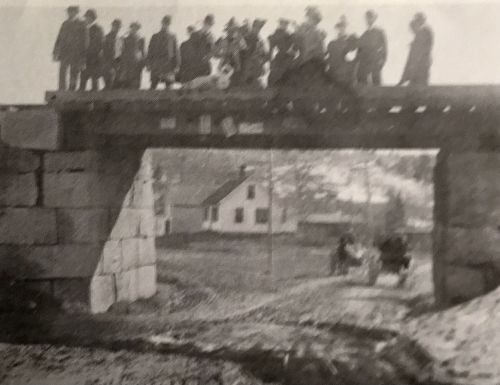
Lebanon Depot
Daniel Webster addressed a gathering in Lebanon at the opening of the Northern Railroad on November 17, 1847, promising a great future for the “Iron Horse.” The line ran 143 miles from North Station, Boston to White River Jct, VT
1848 Northern RR Schedule and Rates
– Trains Left White River Junction for Concord:
• 7:05 am and 12:55 pm
– Trains Left Concord for White River Junction:
• 10:30 am and 3:00 pm
Approximate travel time = 2 1/2 hours @ 23 mph
– Ticket costs:
• Lebanon to Concord = $1.75
• Lebanon to Boston = $3.25
– Freight costs Lebanon to Boston:
• $.32 per 100 lbs. 1st Class
• $.27 per 100 lbs. 2nd Class

Scytheville Underpass
When the Northern Railroad was first completed there was an open crossing at the Scytheville end of Mascoma Street. (“Scytheville” because of the Purmort Edge Tool Company that made scythes there on Slayton Hill.) In 1859 the Railroad paid for a change in the road and the Scytheville Underpass was built. This picture shows the underpass after it was rebuilt in 1888-1889. (Photo and info from 50 Old Bridges of Lebanon, New Hampshire by Robert H. Leavitt and Bernard F. Chapman.)

“Tell-tale”

Mile Marker 139
Erected before the Civil War by the new Northern Railroad to mark distances from Concord to White River Jct., the mile markers along the rails were relocated when the line was absorbed by the Boston & Maine in 1887. The posts then ticked off the 143 miles from Mile 0.00 at B – North Station, Boston – to the terminus at WRJ – Mile 142.92 in VT. (Thanks to the Northern Rail Trail sitefor this information.)
By the 1890s rail transportation was very heavy on the Boston & Maine Railroad. Lebanon’s Granite State Free Press, June 30, 1893 reported, “There are 34 regular passenger and freight trains over the railroad here every 24 hours. Pretty good for a one track line.”

West Lebanon Depot
Lebanon’s railroad era was brought to a close with the end of passenger service in the 1960s and the eventual abandonment of most of the freight line in the 1980s. The rail corridor was purchased by the State of New Hampshire when the railroad abandoned the line in 1996.
More info of the coming of the railroads into the Upper Valley
Info on the history of the Northern Rail Trail development

